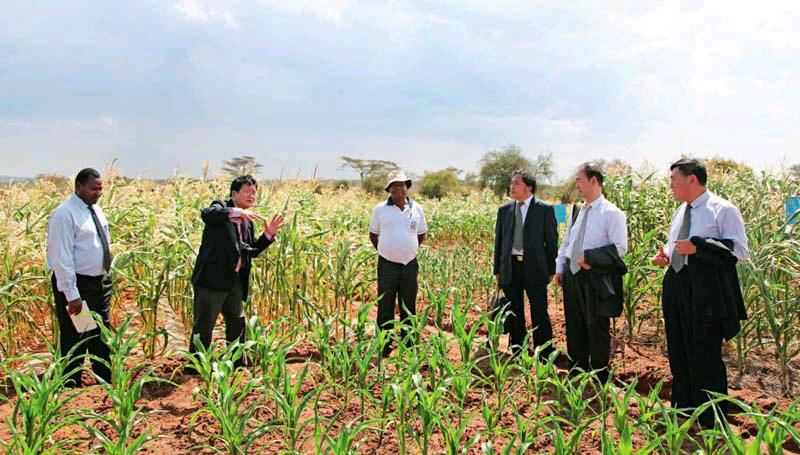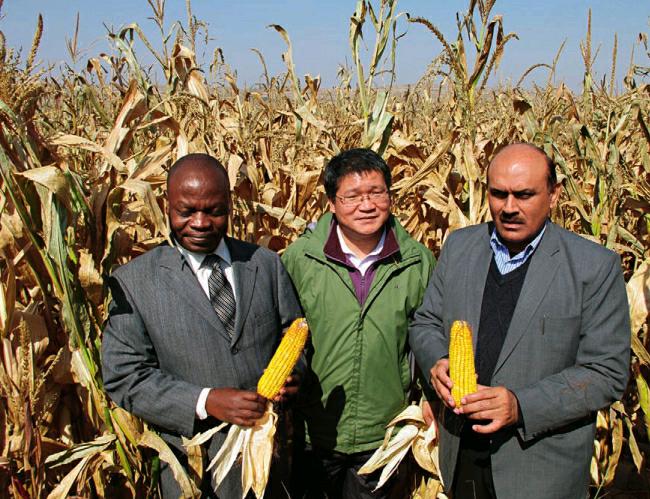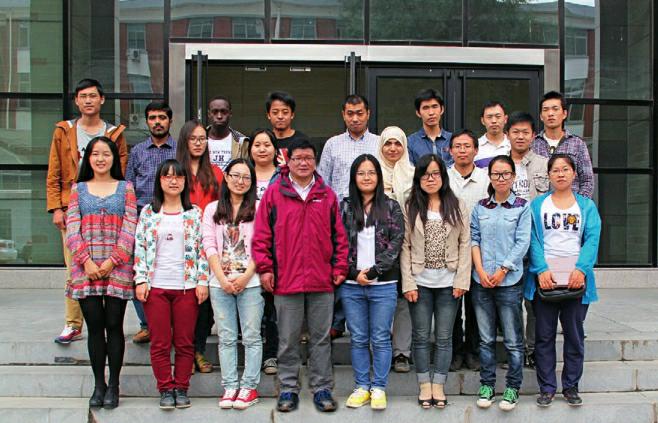Coupled Ecology and Agriculture Revived on Arid Land
By+HUANG+YUANJUN+&+LIU+XIAOTONG
THE Yellow River flows across Lanzhou city, Gansu Province in northwest China. One does not realize Chinas vastness unless visiting in person the countrys northwest. Here the land is immense. However, drought, desertification, scant vegetation, water and soil erosion have resulted in low agricultural productivity and huge ecosystem cri- ses. Making ecological progress and carrying out sustainable development in this region, therefore, becomes a considerable challenge. Covering a large area, northwestern China plays an important part in the national strategies of promoting agricultural and ecological progress through application of scientific and technological advances. In this case, promoting agricultural productivity and ecosystem conservation take priority in the three agriculture-related issues of agriculture, farmers, and rural areas.
“The environment in Northwest China is extremely fragile. Ecological awareness must be raised at both the national and regional levels,” Xiong Youcai, professor at the School of Life Sciences of Lanzhou University, said.“Faced with sharp contradictions between humans and nature, a regimen of‘promoting ecological advancement over a large region while boosting production in small areas should be in place. This will achieve sustainable development of a coupled ecosystem, economy, and society through facilitating coordinated development of agriculture and animal husbandry, and paying equal attention to converting farmlands into forests or grasslands, while simultaneously increasing farmers income,” he added.
Agro-ecology Research on the Banks of the Yellow River
The agricultural ecosystem and evolution research team, headed by Professor Xiong Youcai, originates in Lanzhou Universitys prominent ecology program. Sixteen years ago, Xiong left his picturesque hometown in Hubei Province for desolate Gansu, where natural conditions are entirely different. Professor Xiong explained in lay terms his research field.
Covering an area of over 640,000 sq kilometers, the Loess Plateau in Northwest China is regarded as an ecosystem conservation area incapable of withstanding intense human activities, and not suitable for large scale agricultural production. Nevertheless, the fundamental necessity of nourishing and providing development opportunities for the 34 million people living on the plateau remains an unavoidable reality. Improving farmers livelihoods and at the same time restoring local ecosystem on this bleak yet comparatively densely populated land is a scientific conundrum.endprint
With the aim of reconciling contradictions between production and ecology and seeking a sustainable development mode, Professor Xiong leads his teams search for a better way to “promote ecological advancement over a large region while boosting production in smaller areas.” This idea, when applied to the hilly-gully regions of the Loess Plateau, can be put into practice by transferring agricultural production from fragile areas like hillsides and tablelands to plains and foothills. In other words, intensified agriculture is carried out in plain fields, and ecosystem conservation in environmentally fragile areas.
Professor Xiong impresses on his postgraduate students that scientific research is built on previous discoveries and contributions in the course of work by scientists from one generation to an- other. Since the 1980s, scientists in Lanzhou University have been conducting the researches on rainwater-harvesting agricultural systems and ecological restoration programs that contribute to alleviating the food security issue.
Upon hearing Lanzhou University Professor Zhao Songlings report in 1995, then Chinese Premier Li Peng pointed out that rainwater harvesting was the ideal solution to agricultural problems in semi-arid areas. Later, in 1999, an advisory report compiled by Lanzhou University and Chinese Academy of Sciences was submitted to the State Council. It showed that four technologies, including rain-harvesting and water-saving, gully and slope gov- ernance, sustainable agriculture, and dry-lot feeding, are key elements to sustainably developing agriculture on the Loess Plateau. In 2002, Professor Li Fengmin formulated the ecological rainwater harvesting theory in which environment-friendly management concepts are integrated.
Xiong Youcai told his students: “It is the effort made by generations upon generations in agricultural rainwater harvesting researches that has helped farmers and herdsmen in northwestern China solve food security problems. For instance, there are now 15 million hectares of corn planting areas in Gansu Province, so hugely benefiting neighboring Shaanxi Province, and crop production has stimulated the extension of animal husbandry industry chain.”
Nevertheless, there is still room for improvement in the current theory of agricultural rainwater harvesting. Such problems as plastic film residue, decline of field productivity, under-utilization of rainfall infiltration in growing seasons, reduced soil moisture storage capacity, imbalances in the soil of carbon, nitrogen, and phosphorus, and reduced incomes despite farmers rising output all demand prompt solutions. They necessitate breakthroughs and innovations in basic theories and technologies, and studies that combine natural with social factors.endprint

Professor Xiongs team has been focusing on these problems. The technique the team recently developed of ridgesowing and alternative furrow-mulching raises the on-site rainfall infiltration efficiency in growing seasons and increases the capacity of soil moisture storage, and also the carbon nitrogen ratio. It is now being promoted among local farmers.
Professor Xiong believes that Darwins theory of evolution leads the way to agricultural development in Northwest China. He takes the farming mode in accordance with precipitation rhythm as an example. To relieve the discrepancy between natural rainfall and crop water demand at different seasons, he suggests reducing spring-sown crops and instead, increasing summer-sown crops, like corn and potatoes. Academic circles, however, have long deemed this method infeasible. But practice has proven that changing the types of crops achieves the required levels of thermo and rain matching over the same period, so expanding the application scope of micro-field rainwater harvesting in larger regions. This is helpful in transferring human activities from broad, environmentally fragile areas to small plots of valley land and plain fields. Production and consequently incomes are therefore expected to increase, and ecological restoration in large areas enhanced accordingly. An innovative application of Darwins theory, the mode of rain-matching farming has been enriched and further developed.
Human Benefits from Scientific Research
Professor Xiong and his colleagues adhere to the spirit of hands-on research. “I come to the universitys field experimental station once or twice a week,” one of Xiong Youcais students said. “Its an ideal place for scientific research. Here, with the professors guidance, we study, practice, and temper our willpower.”
Zhonglianchuan Village, where the field station is located, has extremely limited access to water and electricity. All team members must rely on a few water cellars. Despite poor conditions, the professor and his students patiently toil over their research. Sloping fields covering an area of 80 mu (5.3 hectares) and terraced fields provide them with typical samples.
“The village has 120 households,” a villager said. “All our corn fields are now covered with mulch. In the past, the output was around 150 to 200 kilograms per mu (0.0667 hectares) under tradi- tional flat planting mode. Now it could reach 500 kilograms per mu. My family of four has 20 mu (1.3 hectares) of cornfields. As the output has now increased to 500 kilograms per mu, we can live on a plantation that generates an income of more than RMB 20,000.”endprint
It is important in dry areas to upgrade the techniques of water retention, evaporation inhibition, and rainwater collection. The ridge-furrow plastic-mulching technique is crucial in this regard. According to Professor Xiong, the mechanism of this technique to increase yield is mainly geared to improving water and temperature conditions. Putting mulch on dry topsoil effectively retains and utilizes water. Airtight mulch prevents vertical water evaporation and directs it in a more lateral flow. The retention of water in soil more effectively coordinates the water demands of crop growth and makes better use of deep soil water.
The Zhao family in the village comprises five members. The head of the household said: “We never grew corn before because of water shortages and cold weather. It was not until 1996, when the experimental planting succeeded, that villagers began to plant corn using the technique of ridge-furrow mulching.”He went on, “Now my fields yield 350 kilograms per mu. Covering an area of three mu (0.2 hectares), the corn I plant generates an income of over RMB 2,000, which was unbelievable in the past.”
Baishigou in Yuzhong County of Lanzhou is a national key demonstration base for dryland agriculture. Corn grows particularly well here in its fields. “Look, ripe corn has turned the hills golden,”Professor Xiong said to one of his Kenyan students. All corn in this region is planted using the micro-field rain-harvesting technique. Adjustment of planting structure and extension of farming technologies have boosted both the perunit yield and farmers incomes.
Shuanglonggou Village also benefits from this technique. “Our village has the largest area of corn fields, and they are all covered with agricultural films according to the technique we learnt from Professor Xiongs team. In this way, thermo and moisture in the soil are well preserved,” one of the locals explained. Villagers are delighted at the rise in corn yield from 170 kilograms per mu to 600 kilograms per mu. “Thanks to this technology, we have a stable net income of more than RMB 1,000 on a mu basis. Professor Xiong and his students visit our village three or four times a year to teach us planting techniques,” a villager said.
However it was difficult for people to accept these new scientific achievements. At first farmers refused to buy into the mulching idea, and some agricultural experts thought Professor Xiongs team had worked in vain. “But we didnt give up conducting experiments and trial plantings, and eventually succeeded in raising the corn yield by more than seven-fold,” Professor Xiong said. “Our research outputs have benefited farmers in regions where corn was seldom planted due to unfavorable natural conditions. Today, the higher corn yield has brought farmers tangible profits. We are gratified to have made the impossible possible,”the professor said.endprint
Dingxi in central Gansu Province is one of the countrys most arid regions. In the Dingxi Academy of Agricultural Sciences greenhouses, potato seedlings and those of other crops nurtured through ridge-furrow mulching are transported to the fields of thousands of farmers. Dingxis development was formerly inhibited by its unfavorable natural conditions. But in recent years, the citys Academy of Agricultural Sciences has cooperated with research groups from Lanzhou University, which has brought remarkable achievements in scientific studies, education, practice, and talents training.
Help for Africa
Scientific research should join the global flow. Over past five years, Professor Xiong has led his team to Kenya to launch jointly with the United Nations Environment Programme (UNEP) a project in the field of agricultural rainwater-saving on arid land. In Kenya, the team was menaced with the threats of terrorist attacks and kidnappings, water and power shortages, rugged roads and poor transportation, strong ultraviolet radiation, and other hazards. But team members overcame these difficulties and eventually produced satisfactory results.
The first stage of their trials took place in the Katumani region, where the team compared different methods of micro-field rain-harvesting and different types of crops. It also held demonstrations of various techniques for local farmers. Experiments were carried out in 98 quadrats covering an area of 4,500 sq meters. It has since been established that the per-unit yield in the region skyrocketed 90 to 500 percent and water use efficiency to 150 to 780 percent.
Demonstrations were later held and farmer training schools set up in Katumani, Kitui, and Juja. Moreover, after calculations and analyses of soil in various areas, along with climate parameters, Chinese researchers put forward their academic view that although arid and semi-arid regions take up more than 80 percent of Kenyas land, it is possible to produce sufficient food to feed all Kenyans from just one third of the nations arable land. This can be achieved by adopting advanced methods that have been successful in China, such as microfield rain-harvesting and crop management systems.
This outcome, which is of inestimable value in alleviating food crises in Africa, received high commendation from experts at UNEP, South Eastern Kenya University, Kenya Agricultural Research Institute, and Jomo Kenyatta University of Agriculture and Technology. Professor Titus Kanui from South Eastern Kenya University said: “Your experimentation and technology will make a significant contribution to Kenyas food security.”endprint
Research by Professor Xiongs team has also drawn media attention in China and from abroad, as well as from the International Dryland Development Commission, the International Center for Agricultural Research in Dry Areas, and various enterprises, non-government organizations, and farmers associations in Kenya.
According to Professor Zhou Xuhong, Chinese Academy of Engineering academician and former president of Lanzhou University (LZU), the LZU is encouraged to enhance cooperation and exchanges with universities and research institutions in Africa in the course of making itself a world famous university. Research on arid and cold regions constitutes important programs at LZU. In most parts of Africa, drought is an inherent geographical and climatic feature. Hence, the research, programs and talent trainings held in LZU in this field have much to share with African schools. Through demonstration and development of rainfed agriculture in arid regions, Chinas successful experience has been introduced to Africa, so contributing to alleviating food crises and tackling global changes.endprint

